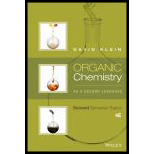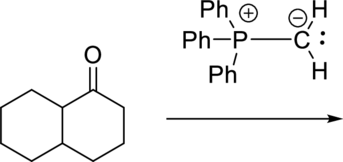
Concept explainers
Interpretation:
Reagent for the given conversion has to be predicted.

Concept Introduction:
Wittig Reaction: It is an organic reaction where an

Non-stabilized ylide (having electron donating group on negatively charged carbon) gives Z-isomer whereas stabilized ylide (having electron withdrawing group on negatively charged carbon) gives E-isomer.
Explanation of Solution
The reaction is shown below:

The starting material is a ketone and the product is an alkene. In-order to do this conversion, Wittig reagent can be used.

The given reactant is a ketone and a simple phosphorus ylide is the reagent. The given reagent is generally known as Wittig reagent and it is used to convert ketone
The reaction is given below:

Want to see more full solutions like this?
Chapter 6 Solutions
Organic Chemistry As a Second Language: Second Semester Topics
- Which diagram is the correct one? What other procedure can be used to solve this problem? write down ways to solve. first, execute plan 1 to solve the problem. Please explain every step. Think about the way that you can use to make sure that your answer makes sense. write down your assessment.arrow_forwardBASIC PURE SUBSTANCE MIXTURE UNIT DESCRIPTION (color; physical state; transparent/translucent/opaque; shiny/dull malleable/ductile, shape and size of particles for solids; odor for organic series only) SAMPLE OF Соmpound (for Pure substances Element MATTER only) Homo- Hetero- atom, molecule, or formula unit Metal Nonmetal Ionic Covalent Series 8. ORGANIC CHEMICALS C,H14(1) Нехane HC,H3O2(aq) C4H3O2(1) ethyl acetate C;H60(1) Acetone CH,O(1) ethyl alcohol (ethanol) C10H3O(s) 1-naphthol C;H,O(1) Benzaldehyde C3H3O2(1) methyl benzoate C,H§O(I) trans-cinnamaldehydearrow_forward(C2) Hello! I just want to ask for help whether the answers in the given pictures are correct. If it's not, please help me recheck and resolve it. Please refer to the given pictures below for the answers and questions. Please read the instructions and directions very carefully. Double and triple check your answers, previous tutors got it wrong. NOTE: Type only your answers. Please do not handwritten your answers. Make sure your formulas, solutions and answers' format are all correct.arrow_forward
- How do you solve this problem? Can you go into details about each step you did to get to the answer and why?arrow_forwardHow do you solve this problem?arrow_forwardPlease keep your response simple, and at the high school level so that I can understand your solution. Please do not overcomplicate your solution with University level workarounds.arrow_forward
- In planning the synthesis of one compound from another, it's just as important to know what not to do as to know what to do. The following reactions all have serious drawbacks to them. Explain the potential problems of each. Just use 1-2 sentences for each. 1.03 2. Zn CHO CHOarrow_forwardHello I just wanted to check my answer for this one and if there is any tips that will help me better understand or work these types of problems out.arrow_forwardI am confused on how to do these problems and my teacher is no helparrow_forward
- Answer this problem as early as possible. I upvote and pray for your wellbeing.arrow_forwardCan you please check if these problems are correct. And elaborate the steps?arrow_forwardEach of the following reactions have mistakes in them, please identify those as completely as you can. اخيرة A) B) HI 1.03 Di 2. Zn 1) BH 2) H2O, OH OHarrow_forward
 Organic ChemistryChemistryISBN:9781305580350Author:William H. Brown, Brent L. Iverson, Eric Anslyn, Christopher S. FootePublisher:Cengage Learning
Organic ChemistryChemistryISBN:9781305580350Author:William H. Brown, Brent L. Iverson, Eric Anslyn, Christopher S. FootePublisher:Cengage Learning
